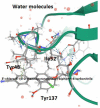FimH and Anti-Adhesive Therapeutics: A Disarming Strategy Against Uropathogens
- PMID: 32664222
- PMCID: PMC7400442
- DOI: 10.3390/antibiotics9070397
FimH and Anti-Adhesive Therapeutics: A Disarming Strategy Against Uropathogens
Abstract
Chaperone-usher fimbrial adhesins are powerful weapons against the uropathogens that allow the establishment of urinary tract infections (UTIs). As the antibiotic therapeutic strategy has become less effective in the treatment of uropathogen-related UTIs, the anti-adhesive molecules active against fimbrial adhesins, key determinants of urovirulence, are attractive alternatives. The best-characterized bacterial adhesin is FimH, produced by uropathogenic Escherichia coli (UPEC). Hence, a number of high-affinity mono- and polyvalent mannose-based FimH antagonists, characterized by different bioavailabilities, have been reported. Given that antagonist affinities are firmly associated with the functional heterogeneities of different FimH variants, several FimH inhibitors have been developed using ligand-drug discovery strategies to generate high-affinity molecules for successful anti-adhesion therapy. As clinical trials have shown d-mannose's efficacy in UTIs prevention, it is supposed that mannosides could be a first-in-class strategy not only for UTIs, but also to combat other Gram-negative bacterial infections. Therefore, the current review discusses valuable and effective FimH anti-adhesive molecules active against UTIs, from design and synthesis to in vitro and in vivo evaluations.
Keywords: FimH; adhesins; affinity; antagonists; mannose-binding lectin; urinary tract infection; uropathogenic Escherichia coli; uropathogenic Klebsiella pneumoniae; uropathogenic Proteus mirabilis.
Conflict of interest statement
The authors declare no conflicts of interest.
Figures




References
-
- Chockalingam A., Stewart S., Xu L., Gandhi A., Matta M.K., Patel V., Sacks L., Rouse R. Evaluation of immunocompetent urinary tract infected Balb/C mouse model for the study of antibiotic resistance development using Escherichia Coli CFT073 infection. Antibiotics. 2019;8:170. doi: 10.3390/antibiotics8040170. - DOI - PMC - PubMed
Publication types
Grants and funding
LinkOut - more resources
Full Text Sources
Other Literature Sources
Research Materials

